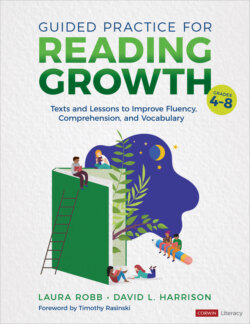Читать книгу Guided Practice for Reading Growth, Grades 4-8 - Laura Robb - Страница 25
На сайте Литреса книга снята с продажи.
Developing Readers Need Four Key Literacy Experiences
ОглавлениеGuided practice lessons can nudge students forward quickly when they are part of a literacy rich classroom that values daily teacher read-alouds, instructional and independent reading, and notebook writing about reading. To move students forward quickly, you’ll have to maintain a balance between:
daily read-alouds, including interactive read-alouds;
instructional reading that includes guided practice, small group instruction, or a workshop approach where students read different texts within a genre or topic;
daily independent reading of self-selected books; and
writing about reading in notebooks.
This four-pronged approach allows you to read aloud to model expressive, fluent reading, enlarge students’ vocabulary and background knowledge, and show students how good readers react to and think about texts. Independent reading offers students the practice they need (but often haven’t had) to enjoy books they choose and want to read (Gambrell, Marinak, Brooker, & McCrea-Andrews, 2011). Finally, students who write about their reading can improve comprehension of a text by 24 percentile points (Graham, Harris, & Santangelo, 2015).
The texts David Harrison and I invite you to use for guided practice lessons are on topics that interest students in Grades 4 on up, but they also challenge their depth of thinking and enlarge their vocabulary and background knowledge. These students don’t have lots of time to grow and improve as readers. By the end of eighth grade, they should be reading close to or on grade level. To support this ambitious goal, all four elements need to be part of your ELA block (see Appendix B for possible schedules).
Teaching Tip
If the lessons students complete indicate there’s not enough progress, it’s important to provide support quickly so small confusions don’t become obstacles to learning. Interventions can be working through lessons one-on-one, pairing a student with a classmate who gets it, or re-teaching using a new short poem or text from Appendix I or a text you choose. Appendix I provides additional original poems and short texts by David Harrison, and Appendixes H and J provide suggested sources for short texts, books, and poetry.
The four elements, like a string quartet, make literacy music for developing (and all) readers because each element offers them the instruction and independent practice they need to become proficient readers.
